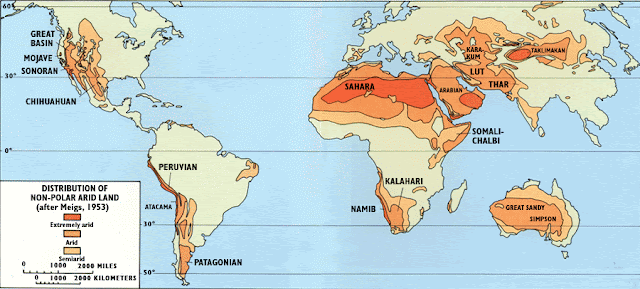SAHARA DESERT
Tuesday, November 27, 2012
Improvement of human impacts on the ecosystem...
What can be done?
1. Hunting regulations:
Since the environment is harsh, it is already extremely difficult for species,
especially larger mammals, to survive. Hunting is and will continue to rapidly
decrease the few existing species populations if regulations are not put into
effect and strictly enforced.
2. Water Oasis
Preservation and Protection: The oasis areas in the Sahara are rare; however,
they also attract the most attention for human exploitation and interference.
Due to current threats of resource exploitation, including oil, they are
vulnerable to significant human impact.
3. Maintain Low
Population Levels: The current status of the Sahara is good in many respects.
Yet, the official status placed on the ecosystem is “vulnerable”. The Sahara
desert is a very fragile ecosystem due to low levels of annual precipitation,
lack of vegetation, and difficulty of species to survive the harsh weather
conditions, especially in the central location of the desert. In order to
maintain low human interference, it is important to keep the ecosystem unharmed
by expanding populations and cities. If they started to intrude on the desert,
it could greatly disrupt its scarce water resources and lead to extinction of
its vulnerable species.
4. Multinational
Agreement: Since the Sahara Desert expands over many countries, the
responsibility is shared to maintain and preserve this vulnerable ecosystem. In
order to effectively do this, some sort of treaty/agreement should be put into
effect immediately. This will ensure that no country is able to exploit resources
or threaten the desert in hopes of benefiting their people or economy.
Future prospects for the Sahara Desert...
Solar Power
There is significant potential for generating electricity from solar
power in the Sahara desert in North Africa for both domestic use and for export
to Europe. The successful implementation of projects to harness solar power
could improve standards of living in North African countries and Europe and
lead to the creation of jobs in the manufacturing and construction
sector.
Egypt and Urbanization
The government has put together an ambitious plan to reclaim 3.4million acres of desert in 10
years, in a project known as the Toshka Project. When complete, the project
will provide new housing, arable land and business complexes suitable for
housing about 16million people. A further 2.8million jobs will be created. In
totality, this project will take immense pressure off Egypt’s rapidly expanding
megalopolis. Environmentalists have been skeptical about the sustainability of
the project, claiming that there will be significant losses from surface
evaporation as the canals pass through searing heat. Pipes will increase
construction cost and even though polymer coating and other technical
arrangements have gone into avoiding seepage losses in the canals, the
environmentalists have a point. From a neutral’s point of view, this project should
succeed.
Vegetation
Scientists
are now seeing signals that the Sahara desert and surrounding regions are
greening due to increasing rainfall. If sustained, these rains could revitalize
drought-ravaged regions, reclaiming them for farming communities. This desert-shrinking
trend is supported by climate models, which predict a return to conditions that
turned the
Sahara into a lush savanna some 12,000 years ago. The study suggests
huge increases in vegetation in areas including central Chad
and western Sudan.
VULNERABLE:
With the prospective solar project, global warming,
and Egypt’s engineering plan to expand cities into the desert, both the natural
environment, particularly the oasis areas, and the animals will be vulnerable
to danger and more exposed to the possibility of extinction.
Subscribe to:
Comments (Atom)


